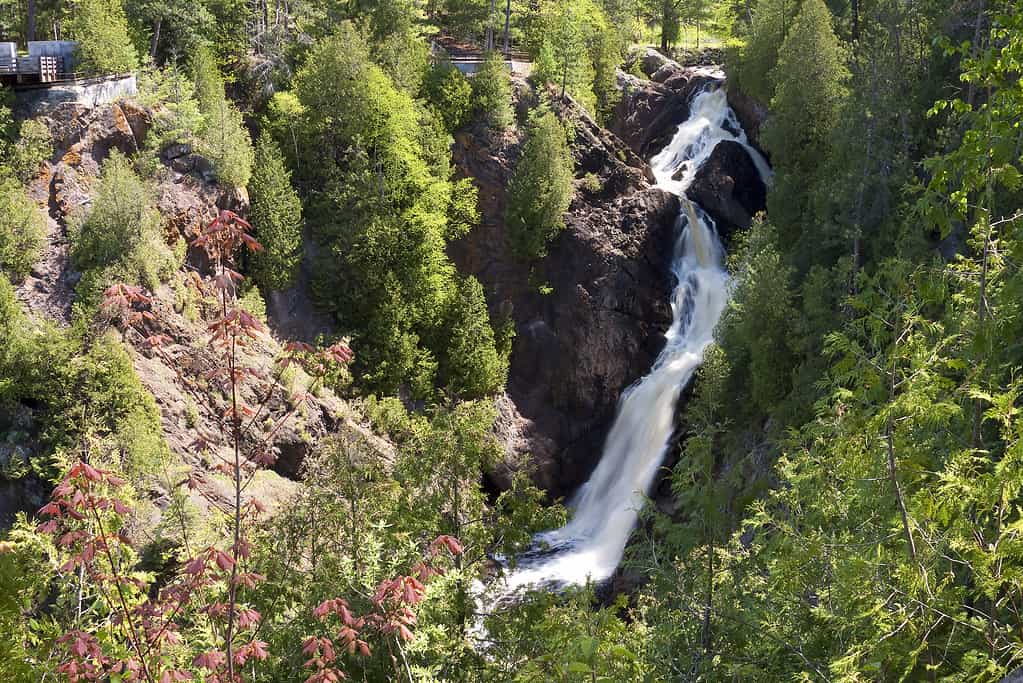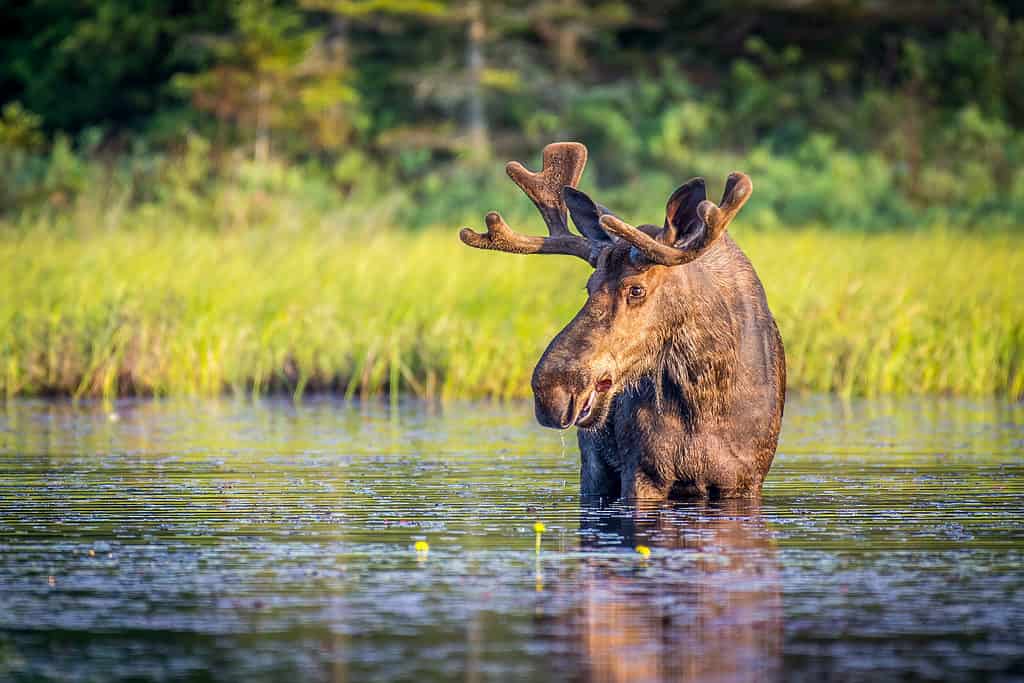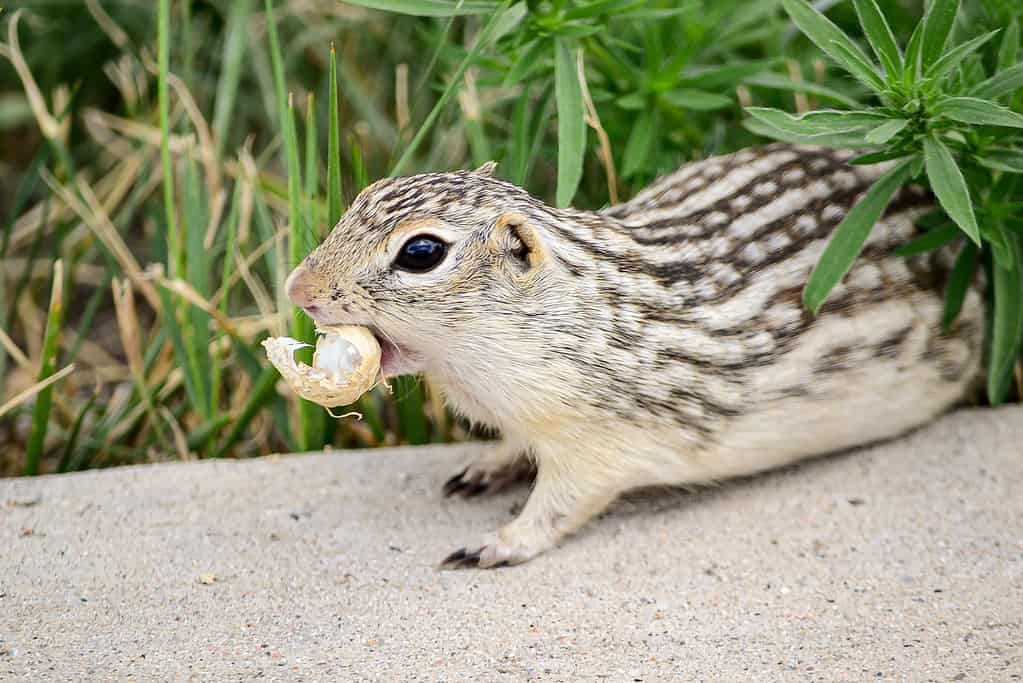Pattison State Park in Douglas, Wisconsin offers many exciting features for any outdoor enthusiast. But this gorgeous park is most famous for featuring the tallest waterfall in Wisconsin! Big Manitou Falls is 165 feet tall, and its thunderous beauty is certainly a sight to behold. Besides this natural wonder, Pattison State Park offers many additional wilderness adventures!
Features

The roaring of the falls grew so deafening that Native American tribes thought it was the vocalizations of the Great Spirit.
©John Brueske/Shutterstock.com
Fed by the Black River, a torrent of brownish water surges down the 165 feet of rocky drops, forming Big Manitou Falls. Sandstone and basalt granules stirred through the waterfall contribute to the brownish tint. Big Manitou Falls is the tallest waterfall in Wisconsin and ranks as fourth fourth-highest waterfall east of the Rocky Mountains.
Frozen for much of the year, Big Manitou Falls is pretty tame until the snow melt comes. With the added water volume, plus the rain that comes with spring, Big Manitou Falls finds its voice. In fact, the roaring of the falls grew so deafening that Native American tribes thought it was the vocalizations of the Great Spirit. Thus, “Gitchi Manitou” is another name for the falls. It means “Great Spirit,” who is the creator god for tribes such as the Ojibwe.
The swirling current sweeps down Big Manitou Falls and eventually joins with the St. Louis River and Lake Superior. Pattison State Park surrounds the falls with 1,476 acres of forest. The forest contains balsam fir, birch, aspen, and spruce trees.
Upstream, Big Manitou Falls has a smaller sibling, the Little Manitou Falls, that is 31 feet tall. But that height can’t compete with the 165-foot drop of the tallest waterfall in Wisconsin.
History of the Tallest Waterfall in Wisconsin
As the glaciers receded a few thousand years ago, the Black River carved a gorge through the sandstone and basalt layers. Erosion continued and formed the steep Big Manitou Falls.
Pattison State Park is named after Martin Pattison, who worked in the lumber and mining industry. Pattison became especially wealthy after he discovered iron ore along the Vermilion Range in Minnesota. In 1917, there were plans to build a power dam on the Black River, which would completely erase Big Manitou Falls.
And so, Pattison discreetly bought up 660 acres along the Black River, effectively stopping the dam development. Then in 1920, Pattison donated the land to the state, and Wisconsin turned it into its sixth state park in Pattison’s honor. One of the projects of Pattison State Park was making trails to Big Manitou Falls. This way, the beautiful waterfall was more accessible and easier for the public to enjoy. It’s just a three-mile walk over trails to experience the falls from many different points.
Today, Big Manitou Falls is owned by the DNR and became a State Natural Area in 2003.

Recreation
Visiting the tallest waterfall in Wisconsin is certainly an attraction of Pattison State Park, but there are many other activities to enjoy as well.
Camping
There are 59 campsites, and 18 of those sites have electric hookups for campers. Each campsite comes with a picnic area, water fountain, telephone, and a handicap-accessible toilet-shower building.
Although there aren’t water or sewer hookups, there is a sanitary dumping station. During the summer, the campsites offer showers and flushable toilets. But during the winter, the water system is turned off. However, there are pit toilets for use during the off-season, and you can get water from the contact station. Pets are welcome, but they must be leashed.
Pattison State Park also offers backpack sites that include vault toilets, tables, and fire rings. You have to bring in your own water and take care of any garbage yourself. But it’s a more secluded way to enjoy the park.
Hiking
Seven miles of hiking trails wind through Pattison State Park. A few circles of Interfalls Lake and others wind along the Black River to the Little Manitou Falls. But the two main trails you will want to hit are the Big Manitou Falls overlook and the one that observes the falls from below, along the Black River. Getting up close and personal with the tallest waterfall in Wisconsin will certainly be worth the hike! On your way, the park provides a geological guide to Big Manitou Falls, which you can follow during your hike.
Animals
Almost 200 species of birds, 54 species of mammals, and many reptiles and amphibians dwell in Pattison State Park. Here are a few unique animals to spot:
Moose

If they get too hot, they cool off in a lake or river. Moose are exceptionally powerful swimmers, so Black River and Interfalls Lake aren’t a challenge.
©Mark Byer/Shutterstock.com
Moose have been spotted in the park, and as herbivores, they need to constantly eat to gain the 10,000 calories a day their bodies require. They have a four-chambered stomach; the first stomach ferments the food, while the other three pull nutrients. What is more amazing is that their four-chamber stomach allows moose to store 100 pounds of food!
Moose love cold climates – they can’t take heat over 80°F. So, this northern Wisconsin state park is perfect for them. If they get too hot, they cool off in a lake or river. Moose are exceptionally powerful swimmers, so Black River and Interfalls Lake aren’t a challenge.
Black-Capped Chickadee
The black-capped chickadee is a naturally curious and friendly bird. In fact, if you are patient and hold out a handful of seeds, a black-capped chickadee may even land in your palm! In the summer, these birds fill up on insects like caterpillars, centipedes, and spiders. But in the lean winter months, a black-capped chickadee will sustain on seeds and berries.
These chickadees are also known for caching food. A chickadee will hide seeds in different spots for the winter, and it can remember thousands of hiding places a month after storing. These sharp birds would never forget where they put their keys!
The Thirteen-Lined Ground Squirrel

The thirteen-lined ground
squirrel
lives up to its name – it really does have 13 stripes!
©BT Images/Shutterstock.com
Thirteen-lined ground squirrels prefer open areas with well-drained soil for their burrows. Thus, you may notice burrows around your campsite, roadsides, or picnic areas. They like to build emergency burrows, which are shallow, dead-end tunnels. They use these to hide from predators. The home burrows are deeper and are used for nesting and hibernation.
The thirteen-lined ground squirrel lives up to its name – it really does have 13 stripes! Seven dark stripes separated by six light stripes run along its body. Often mistaken for a chipmunk, these ground squirrels are very territorial and will run off any small, curious creatures.
Bald Eagles
Bald eagles thrive in colder climates, and northern Wisconsin fits the bill. Because their feathers have great insulating qualities, bald eagles also adjust their feathers to regulate heating. They have two layers of feathers protecting them from the cold. The stiff, outer feathers overlap over fluffy down feathers. The outer feathers wick away moisture and reduce energy loss, keeping the insulating down feathers dry.
Although bald eagles have been spotted around the lake and Black River, the DNR has stopped stocking the lake with sport fish, so the fish population is small and hunting is infrequent.
Where is Big Manitou Falls Located on a Map?
Big Manitou Falls, which is situated within Pattison State Park in Douglas County, Wisconsin, around 13 miles south of Superior, is the highest waterfall in Wisconsin with a height of 165 feet and is found on the Black River, a tributary of the Nemadji River.
Here is Big Manitou Falls on a map:
In Conclusion
Visiting the tallest waterfall in Wisconsin should certainly be on your bucket list if you are in the area. While you are there, spend the weekend camping, hiking the park’s trails, and spotting unique wildlife!
The photo featured at the top of this post is © V-ron/Shutterstock.com
Thank you for reading! Have some feedback for us? Contact the AZ Animals editorial team.






